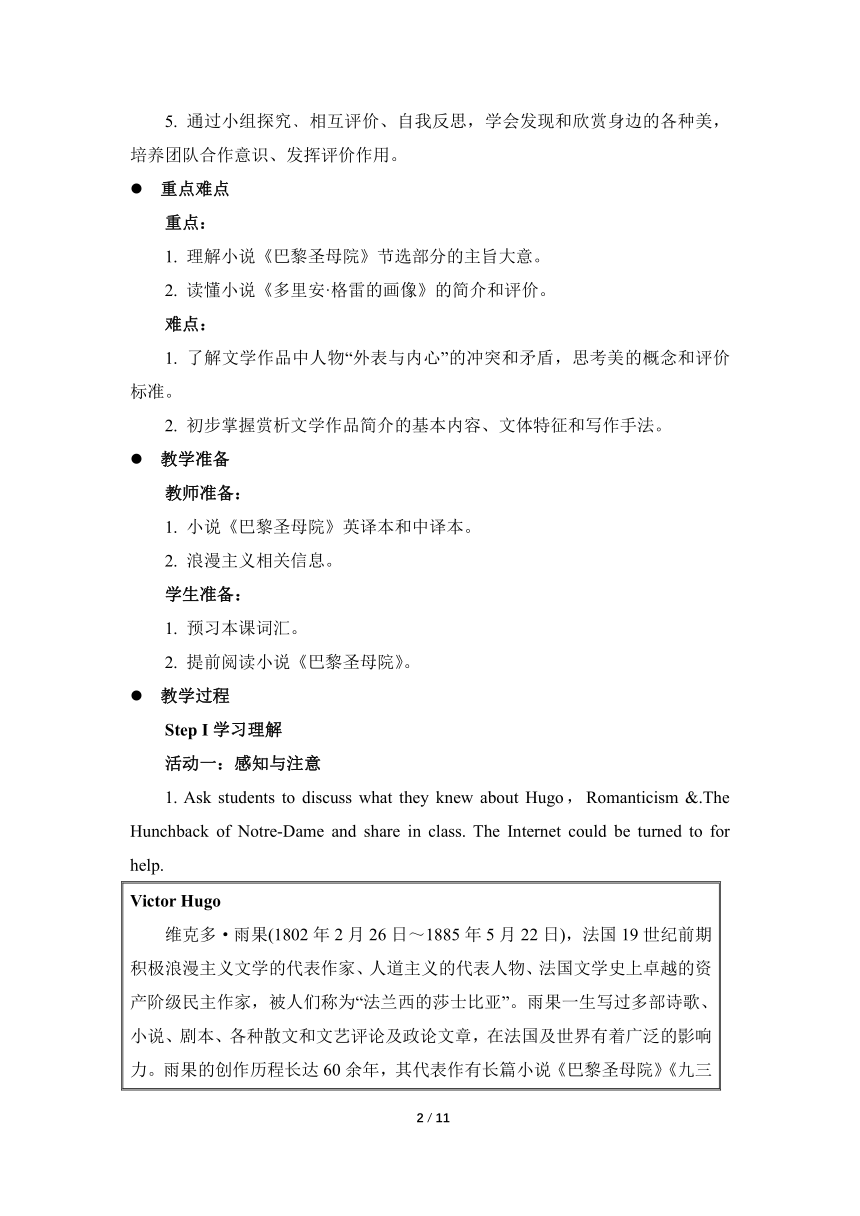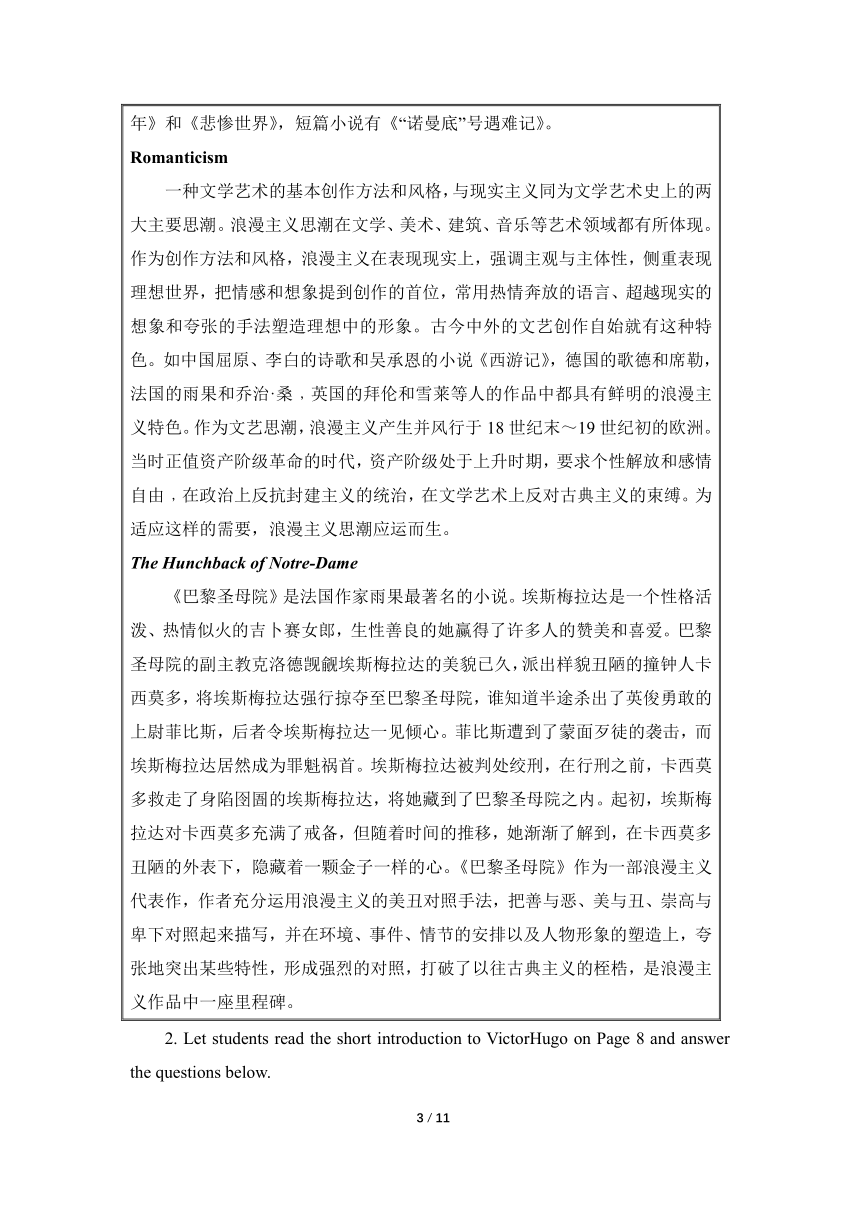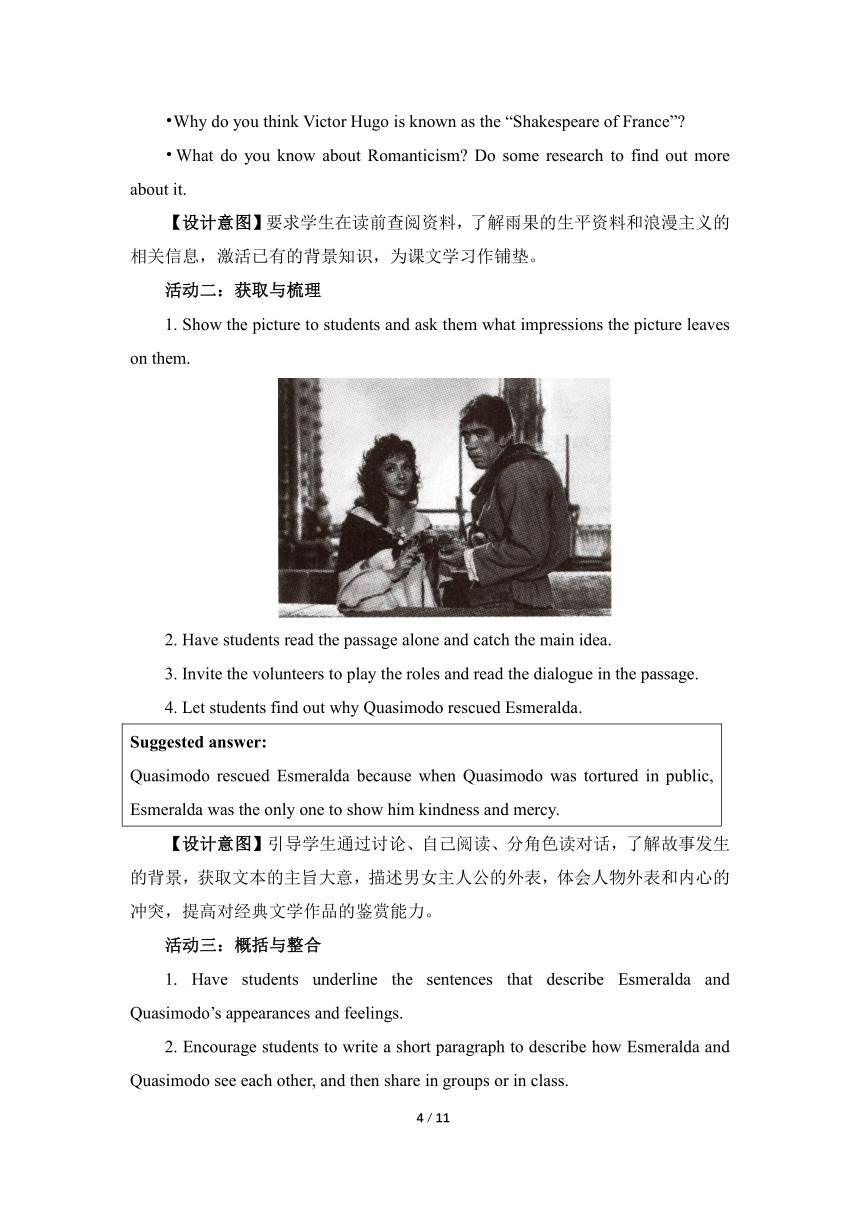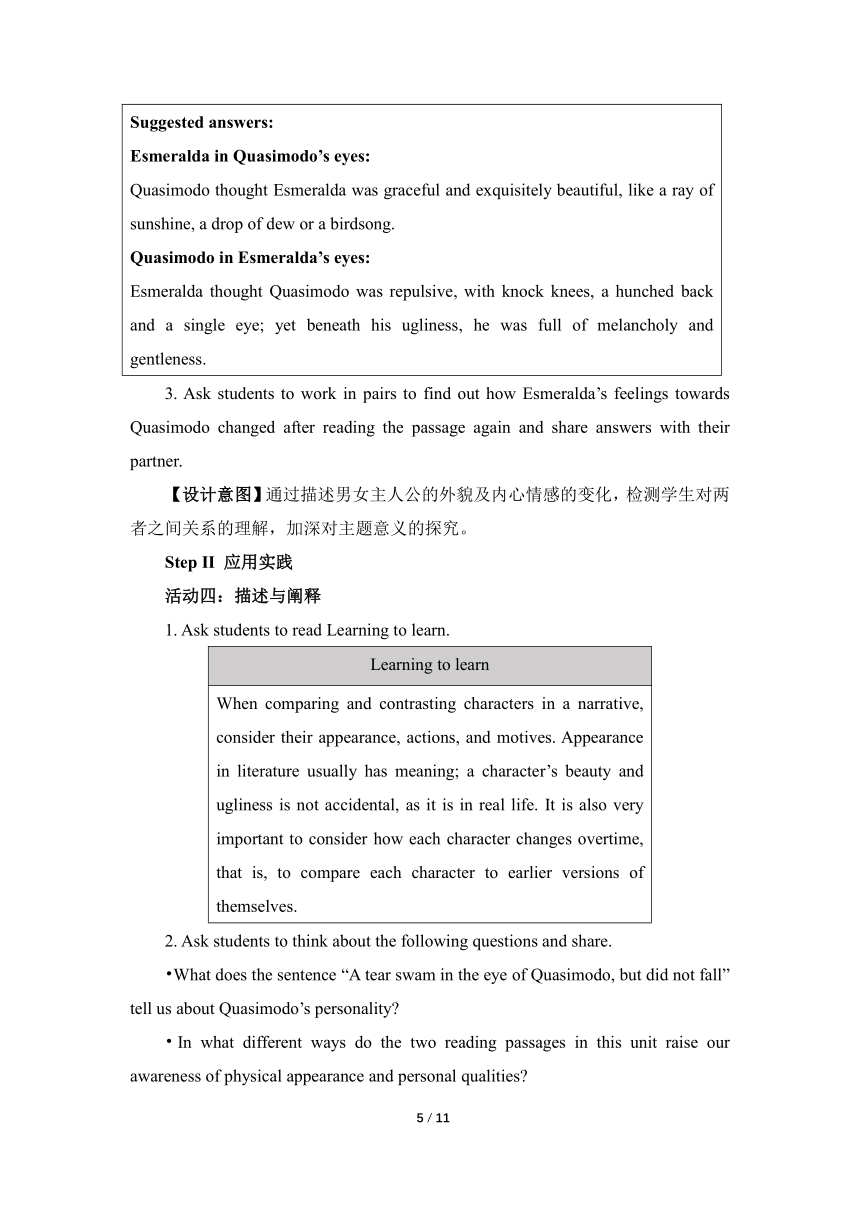外研版(2019)选择性必修第三册 Unit1 Face values Developing ideas and Presenting ideas 名师教学设计
文档属性
| 名称 | 外研版(2019)选择性必修第三册 Unit1 Face values Developing ideas and Presenting ideas 名师教学设计 |  | |
| 格式 | docx | ||
| 文件大小 | 523.6KB | ||
| 资源类型 | 教案 | ||
| 版本资源 | 外研版(2019) | ||
| 科目 | 英语 | ||
| 更新时间 | 2023-03-05 13:07:58 | ||
图片预览





文档简介
Unit 1 Developing ideas & Presenting ideas 名师教学设计
课时内容
主题语境:人与自我、人与社会
主题群:生活与学习、做人与做事、文学
子主题:认识自我,优秀品行,正确的人生态度,文学名著
语篇类型:图片、人物介绍、小说(节选)、文学作品简介、名人名言
文本分析:
[What]本节课包含Developing ideas和 Presenting ideas两部分。
Developing ideas包含两部分:第一部分节选自雨果的小说《巴黎圣母院》,文本主要是围绕男主人公Quasimodo和女主人公 Esmeralda的对话展开,表现了外貌丑陋的Quasimodo内心的痛苦和对美的追求,以及善良美丽的Esmeralda对Quasimodo 态度的变化。第二部分Writing about a literary work是关于小说《多里安·格雷的画像》的简介和评价。
Presenting ideas是关于“美”的名人名言。
[why]本课所有活动均围绕单元主题展开,旨在帮助学生加深对主题意义的理解,初步掌握赏析文学作品简介的基本内容、文体特征和写作手法,思考美的含义和评价标准,总结“什么才是真正的美”。
[How]文本围绕“外表与内心的关系”展开,形式多样,有小说节选、文学作品简介、名人名言。小说节选语言地道,词汇丰富;文学作品简介结构清晰,言简意赅;名人名言与主题贴合度很高。
课时目标
1. 通过阅读,能够理解小说《巴黎圣母院》节选部分的主旨大意,了解文学作品中人物“外表与内心”的冲突和矛盾。
2. 总结和概括男女主人公的外貌特征,思考他们内心情感的变化,理解“人不可貌相”的含义,树立正确的三观和积极的生活态度。
3. 了解文学作品简介的基本内容和结构,能运用所学词汇描述文学作品里某个人物的外表和性格特征。
4. 通过学习名人名言,思考美的概念和评价标准,进一步加深对“美”的理解。
5. 通过小组探究﹑相互评价、自我反思,学会发现和欣赏身边的各种美,培养团队合作意识、发挥评价作用。
重点难点
重点:
1. 理解小说《巴黎圣母院》节选部分的主旨大意。
2. 读懂小说《多里安·格雷的画像》的简介和评价。
难点:
1. 了解文学作品中人物“外表与内心”的冲突和矛盾,思考美的概念和评价标准。
2. 初步掌握赏析文学作品简介的基本内容、文体特征和写作手法。
教学准备
教师准备:
1. 小说《巴黎圣母院》英译本和中译本。
2. 浪漫主义相关信息。
学生准备:
1. 预习本课词汇。
2. 提前阅读小说《巴黎圣母院》。
教学过程
Step I学习理解
活动一:感知与注意
1. Ask students to discuss what they knew about Hugo,Romanticism &.The Hunchback of Notre-Dame and share in class. The Internet could be turned to for help.
Victor Hugo 维克多·雨果(1802年2月26日~1885年5月22日),法国19世纪前期积极浪漫主义文学的代表作家、人道主义的代表人物、法国文学史上卓越的资产阶级民主作家,被人们称为“法兰西的莎士比亚”。雨果一生写过多部诗歌、小说、剧本、各种散文和文艺评论及政论文章,在法国及世界有着广泛的影响力。雨果的创作历程长达60余年,其代表作有长篇小说《巴黎圣母院》《九三年》和《悲惨世界》,短篇小说有《“诺曼底”号遇难记》。 Romanticism 一种文学艺术的基本创作方法和风格,与现实主义同为文学艺术史上的两大主要思潮。浪漫主义思潮在文学、美术、建筑、音乐等艺术领域都有所体现。作为创作方法和风格,浪漫主义在表现现实上,强调主观与主体性,侧重表现理想世界,把情感和想象提到创作的首位,常用热情奔放的语言、超越现实的想象和夸张的手法塑造理想中的形象。古今中外的文艺创作自始就有这种特色。如中国屈原、李白的诗歌和吴承恩的小说《西游记》,德国的歌德和席勒,法国的雨果和乔治·桑﹐英国的拜伦和雪莱等人的作品中都具有鲜明的浪漫主义特色。作为文艺思潮,浪漫主义产生并风行于18世纪末~19世纪初的欧洲。当时正值资产阶级革命的时代,资产阶级处于上升时期,要求个性解放和感情自由﹐在政治上反抗封建主义的统治,在文学艺术上反对古典主义的束缚。为适应这样的需要,浪漫主义思潮应运而生。 The Hunchback of Notre-Dame 《巴黎圣母院》是法国作家雨果最著名的小说。埃斯梅拉达是一个性格活泼、热情似火的吉卜赛女郎,生性善良的她赢得了许多人的赞美和喜爱。巴黎圣母院的副主教克洛德觊觎埃斯梅拉达的美貌已久,派出样貌丑陋的撞钟人卡西莫多,将埃斯梅拉达强行掠夺至巴黎圣母院,谁知道半途杀出了英俊勇敢的上尉菲比斯,后者令埃斯梅拉达一见倾心。菲比斯遭到了蒙面歹徒的袭击,而埃斯梅拉达居然成为罪魁祸首。埃斯梅拉达被判处绞刑,在行刑之前,卡西莫多救走了身陷囹圄的埃斯梅拉达,将她藏到了巴黎圣母院之内。起初,埃斯梅拉达对卡西莫多充满了戒备,但随着时间的推移,她渐渐了解到,在卡西莫多丑陋的外表下,隐藏着一颗金子一样的心。《巴黎圣母院》作为一部浪漫主义代表作,作者充分运用浪漫主义的美丑对照手法,把善与恶、美与丑、崇高与卑下对照起来描写,并在环境、事件、情节的安排以及人物形象的塑造上,夸张地突出某些特性,形成强烈的对照,打破了以往古典主义的桎梏,是浪漫主义作品中一座里程碑。
2. Let students read the short introduction to VictorHugo on Page 8 and answer the questions below.
Why do you think Victor Hugo is known as the “Shakespeare of France”
What do you know about Romanticism Do some research to find out more about it.
【设计意图】要求学生在读前查阅资料,了解雨果的生平资料和浪漫主义的相关信息,激活已有的背景知识,为课文学习作铺垫。
活动二:获取与梳理
1. Show the picture to students and ask them what impressions the picture leaves on them.
2. Have students read the passage alone and catch the main idea.
3. Invite the volunteers to play the roles and read the dialogue in the passage.
4. Let students find out why Quasimodo rescued Esmeralda.
Suggested answer: Quasimodo rescued Esmeralda because when Quasimodo was tortured in public, Esmeralda was the only one to show him kindness and mercy.
【设计意图】引导学生通过讨论、自己阅读、分角色读对话,了解故事发生的背景,获取文本的主旨大意,描述男女主人公的外表,体会人物外表和内心的冲突,提高对经典文学作品的鉴赏能力。
活动三:概括与整合
1. Have students underline the sentences that describe Esmeralda and Quasimodo’s appearances and feelings.
2. Encourage students to write a short paragraph to describe how Esmeralda and Quasimodo see each other, and then share in groups or in class.
Suggested answers: Esmeralda in Quasimodo’s eyes: Quasimodo thought Esmeralda was graceful and exquisitely beautiful, like a ray of sunshine, a drop of dew or a birdsong. Quasimodo in Esmeralda’s eyes: Esmeralda thought Quasimodo was repulsive, with knock knees, a hunched back and a single eye; yet beneath his ugliness, he was full of melancholy and gentleness.
3. Ask students to work in pairs to find out how Esmeralda’s feelings towards Quasimodo changed after reading the passage again and share answers with their partner.
【设计意图】通过描述男女主人公的外貌及内心情感的变化,检测学生对两者之间关系的理解,加深对主题意义的探究。
Step Ⅱ 应用实践
活动四:描述与阐释
1. Ask students to read Learning to learn.
Learning to learn
When comparing and contrasting characters in a narrative, consider their appearance, actions, and motives. Appearance in literature usually has meaning; a character’s beauty and ugliness is not accidental, as it is in real life. It is also very important to consider how each character changes overtime, that is, to compare each character to earlier versions of themselves.
2. Ask students to think about the following questions and share.
What does the sentence “A tear swam in the eye of Quasimodo, but did not fall” tell us about Quasimodo’s personality
In what different ways do the two reading passages in this unit raise our awareness of physical appearance and personal qualities
Suggested answers: On one hand, it shows that Quasimodo is sensitive and gentle; on the other hand, it shows his strength and pride. The first passage shows the true meaning of beauty. Though how you present yourself to others plays apart, accepting yourself and feeling confident about your physical appearance are most important. The second passage highlights how someone’s physical appearance can actually be a complete contrast to who they are on the inside.
活动五:分析与判断
1. Imagine.
(1) Ask students to imagine what difficulties people like Quasimodo might face in the real world and how these people should be treated.
(2) Encourage students to share their thoughts and then present in class.
(3) The whole class try to put forwards ways to deal with these difficulties.
2. Predict.
(1) Ask students to predict what happens next and share their ideas with the class.
(2) The whole class make judgment on whose prediction is the most reasonable and logical.
(3) Tell students to read the novel after class and check their predictions.
【设计意图】在学习理解的基础上,引导学生围绕主题,对文本展开讨论和描述,并结合实际发挥想象“现实生活中,像卡西莫多这样的人会遇到什么困难以及怎么解决”。通过预测接下来发生的故事,培养学生的高阶思维。
活动六:内化与运用
1. Direct students to give a talk about the character in the passage that makes the greatest impression on them.
2. Tell students to organise their ideas by considering the questions.
What is the character like
Has he/she experienced any emotional changes If so, what changes are they
What can you learn from him/ her
3. Have students present their ideas in their group.
4. Let students collect all their group’s ideas and present them to the class.
5. Make students think about whether they can express themselves clearly or understand others in the group talk, and what their strengths or weaknesses are, compared to those of the others in their group.
【设计意图】要求学生从课文中选出印象最深刻的角色,并谈论自己的看法,启发学生独立思考的能力,培养学生的语言表达能力和思维创新能力,达到学以致用的目的。同时通过自我反思,检测学生对文本的理解程度。
Step Ⅲ 迁移创新
活动七:Writing
1. Direct students to read the introduction to the novel on Page 11 and answer the questions.
What kind of person is Dorian Gray
What message do you think the novel conveys
2. Request students to choose another literary work with a focus on physical appearances and personal qualities, such as The Hunchback of Notre-Dame, and complete the notes.
General introduction: _________________________________________________ Plot: _______________________________________________________________ Central theme(s): _____________________________________________________
3. Encourage students to write about this literary work based on their notes.
4. Ask students to make improvements to each other’s introductions and share them with the class.
范文: Jane Eyre Jane Eyre, written by Charlotte Bronte and first published in 1847, tells the timeless story of the love between a poor young governess and a rich and mysterious gentleman. After leaving the orphanage where she has spent most of her childhood, Jane Eyre goes to work as the governess of the daughter of a wealthy but troubled landowner. As she comes to know the great house and the people who live and work within it, Jane begins to uncover the secret responsible for Rochester’s temper and reticence. They fall in love, but just when their happily ever after seems to be in sight, that secret threatens to tear them apart.
Jane Eyre looks at how people should not be underestimated because of the way they look—Jane might be small and plain, but she is also strong, courageous and independent. Although she is a woman and from a lower social class than Rochester,she wants to prove herself his equal in spirit.
【设计意图】引导学生学习和了解小说简介的文体结构,指导学生选择另一本包含“人物外表和个人品质”的文学作品,并仿照范文,完成该文学作品简介的初稿和终稿,提高学生的语言综合运用能力。
活动八:Presenting ideas
1. Have students work in groups, learn the background and read the quote.
Background information: Anton Pavlovich Chekhov (1860~1904) Russian playwright Anton Pavlovich Chekhov is acclaimed as one of the greatest short fiction writers in literary history. Although he was a doctor by profession, his works—including The Lady with the Dog and Ward No.6—were among the most influential in the development of the modern short story. His four famous plays, The Seagull, The Three Sisters, Uncle Vanya and The Cherry Orchard are performed regularly, and have been adapted for films many times. In them, Chekhov explores the themes of love, desire, happiness, power, poverty and social expectations. The quote A human being should be entirely beautiful: the face, the clothes, the mind, the thoughts. From Uncle Vanya by Anton Pavlovich Chekhov
2. Ask students to discuss the questions.
What is your understanding of the quote
What is your definition of “true beauty”
What qualities should a “beautiful person” have
3. Encourage students to think of someone they want to recommend as “the most beautiful person they know”. Have them choose someone they know and complete the table.
Name
Description of him/her Appearance:
Personality:
Reasons to recommend him/her
4. Have students work in groups,discuss who is “the most beautiful person they know” and agree on the best candidate.
5. Tell students to prepare short presentations and consider the following:
the structure of the presentation
useful words, expressions and structures
6. Let students give their presentations and recommend their candidates to the class. Ask them to vote for the best presentation.
【设计意图】要求学生阅读名人名言,思考“美”的内涵,表达自己的见解,学会观察身边的真善美,加深对“美”和主题意义的理解,发展思维品质,实现知识和能力的迁移,促进能力向素养的转化。
活动九:Reflection
Ask students to write reflections after completing this unit. Have them consider the following:
What is your understanding of true beauty
What text types have you learnt about What are their features
What words, expressions and structures have you learnt
What improvement have you made in understanding different cultures
What improvement have you made in using learning strategies and exploring effective ways of learning
What improvement have you made in analysing and solving problems
【设计意图】要求学生从文本、语言、文化、学习策略、学习方法﹑分析和解决问题的能力等方面进行自我评价和总结,检测自己对本单元的理解程度,并寻找改进方法和完善学习策略。
板书设计
Unit 1 Face values Period IV Developing ideas & Presenting ideas I. 学习理解 活动一:感知与注意 1. Discuss. 2. Read and answer. 活动二:获取与梳理 活动三:概括与整合 Ⅱ. 应用实践 活动四:描述与阐释 1. Learning to learn. 2. Think and share. 活动五:分析与判断 1. Imagine. 2. Predict. 活动六:内化与运用 Ⅲ. 迁移与创新 活动七:Writing 活动八:Presenting ideas 活动九:Reflection
2 / 2
课时内容
主题语境:人与自我、人与社会
主题群:生活与学习、做人与做事、文学
子主题:认识自我,优秀品行,正确的人生态度,文学名著
语篇类型:图片、人物介绍、小说(节选)、文学作品简介、名人名言
文本分析:
[What]本节课包含Developing ideas和 Presenting ideas两部分。
Developing ideas包含两部分:第一部分节选自雨果的小说《巴黎圣母院》,文本主要是围绕男主人公Quasimodo和女主人公 Esmeralda的对话展开,表现了外貌丑陋的Quasimodo内心的痛苦和对美的追求,以及善良美丽的Esmeralda对Quasimodo 态度的变化。第二部分Writing about a literary work是关于小说《多里安·格雷的画像》的简介和评价。
Presenting ideas是关于“美”的名人名言。
[why]本课所有活动均围绕单元主题展开,旨在帮助学生加深对主题意义的理解,初步掌握赏析文学作品简介的基本内容、文体特征和写作手法,思考美的含义和评价标准,总结“什么才是真正的美”。
[How]文本围绕“外表与内心的关系”展开,形式多样,有小说节选、文学作品简介、名人名言。小说节选语言地道,词汇丰富;文学作品简介结构清晰,言简意赅;名人名言与主题贴合度很高。
课时目标
1. 通过阅读,能够理解小说《巴黎圣母院》节选部分的主旨大意,了解文学作品中人物“外表与内心”的冲突和矛盾。
2. 总结和概括男女主人公的外貌特征,思考他们内心情感的变化,理解“人不可貌相”的含义,树立正确的三观和积极的生活态度。
3. 了解文学作品简介的基本内容和结构,能运用所学词汇描述文学作品里某个人物的外表和性格特征。
4. 通过学习名人名言,思考美的概念和评价标准,进一步加深对“美”的理解。
5. 通过小组探究﹑相互评价、自我反思,学会发现和欣赏身边的各种美,培养团队合作意识、发挥评价作用。
重点难点
重点:
1. 理解小说《巴黎圣母院》节选部分的主旨大意。
2. 读懂小说《多里安·格雷的画像》的简介和评价。
难点:
1. 了解文学作品中人物“外表与内心”的冲突和矛盾,思考美的概念和评价标准。
2. 初步掌握赏析文学作品简介的基本内容、文体特征和写作手法。
教学准备
教师准备:
1. 小说《巴黎圣母院》英译本和中译本。
2. 浪漫主义相关信息。
学生准备:
1. 预习本课词汇。
2. 提前阅读小说《巴黎圣母院》。
教学过程
Step I学习理解
活动一:感知与注意
1. Ask students to discuss what they knew about Hugo,Romanticism &.The Hunchback of Notre-Dame and share in class. The Internet could be turned to for help.
Victor Hugo 维克多·雨果(1802年2月26日~1885年5月22日),法国19世纪前期积极浪漫主义文学的代表作家、人道主义的代表人物、法国文学史上卓越的资产阶级民主作家,被人们称为“法兰西的莎士比亚”。雨果一生写过多部诗歌、小说、剧本、各种散文和文艺评论及政论文章,在法国及世界有着广泛的影响力。雨果的创作历程长达60余年,其代表作有长篇小说《巴黎圣母院》《九三年》和《悲惨世界》,短篇小说有《“诺曼底”号遇难记》。 Romanticism 一种文学艺术的基本创作方法和风格,与现实主义同为文学艺术史上的两大主要思潮。浪漫主义思潮在文学、美术、建筑、音乐等艺术领域都有所体现。作为创作方法和风格,浪漫主义在表现现实上,强调主观与主体性,侧重表现理想世界,把情感和想象提到创作的首位,常用热情奔放的语言、超越现实的想象和夸张的手法塑造理想中的形象。古今中外的文艺创作自始就有这种特色。如中国屈原、李白的诗歌和吴承恩的小说《西游记》,德国的歌德和席勒,法国的雨果和乔治·桑﹐英国的拜伦和雪莱等人的作品中都具有鲜明的浪漫主义特色。作为文艺思潮,浪漫主义产生并风行于18世纪末~19世纪初的欧洲。当时正值资产阶级革命的时代,资产阶级处于上升时期,要求个性解放和感情自由﹐在政治上反抗封建主义的统治,在文学艺术上反对古典主义的束缚。为适应这样的需要,浪漫主义思潮应运而生。 The Hunchback of Notre-Dame 《巴黎圣母院》是法国作家雨果最著名的小说。埃斯梅拉达是一个性格活泼、热情似火的吉卜赛女郎,生性善良的她赢得了许多人的赞美和喜爱。巴黎圣母院的副主教克洛德觊觎埃斯梅拉达的美貌已久,派出样貌丑陋的撞钟人卡西莫多,将埃斯梅拉达强行掠夺至巴黎圣母院,谁知道半途杀出了英俊勇敢的上尉菲比斯,后者令埃斯梅拉达一见倾心。菲比斯遭到了蒙面歹徒的袭击,而埃斯梅拉达居然成为罪魁祸首。埃斯梅拉达被判处绞刑,在行刑之前,卡西莫多救走了身陷囹圄的埃斯梅拉达,将她藏到了巴黎圣母院之内。起初,埃斯梅拉达对卡西莫多充满了戒备,但随着时间的推移,她渐渐了解到,在卡西莫多丑陋的外表下,隐藏着一颗金子一样的心。《巴黎圣母院》作为一部浪漫主义代表作,作者充分运用浪漫主义的美丑对照手法,把善与恶、美与丑、崇高与卑下对照起来描写,并在环境、事件、情节的安排以及人物形象的塑造上,夸张地突出某些特性,形成强烈的对照,打破了以往古典主义的桎梏,是浪漫主义作品中一座里程碑。
2. Let students read the short introduction to VictorHugo on Page 8 and answer the questions below.
Why do you think Victor Hugo is known as the “Shakespeare of France”
What do you know about Romanticism Do some research to find out more about it.
【设计意图】要求学生在读前查阅资料,了解雨果的生平资料和浪漫主义的相关信息,激活已有的背景知识,为课文学习作铺垫。
活动二:获取与梳理
1. Show the picture to students and ask them what impressions the picture leaves on them.
2. Have students read the passage alone and catch the main idea.
3. Invite the volunteers to play the roles and read the dialogue in the passage.
4. Let students find out why Quasimodo rescued Esmeralda.
Suggested answer: Quasimodo rescued Esmeralda because when Quasimodo was tortured in public, Esmeralda was the only one to show him kindness and mercy.
【设计意图】引导学生通过讨论、自己阅读、分角色读对话,了解故事发生的背景,获取文本的主旨大意,描述男女主人公的外表,体会人物外表和内心的冲突,提高对经典文学作品的鉴赏能力。
活动三:概括与整合
1. Have students underline the sentences that describe Esmeralda and Quasimodo’s appearances and feelings.
2. Encourage students to write a short paragraph to describe how Esmeralda and Quasimodo see each other, and then share in groups or in class.
Suggested answers: Esmeralda in Quasimodo’s eyes: Quasimodo thought Esmeralda was graceful and exquisitely beautiful, like a ray of sunshine, a drop of dew or a birdsong. Quasimodo in Esmeralda’s eyes: Esmeralda thought Quasimodo was repulsive, with knock knees, a hunched back and a single eye; yet beneath his ugliness, he was full of melancholy and gentleness.
3. Ask students to work in pairs to find out how Esmeralda’s feelings towards Quasimodo changed after reading the passage again and share answers with their partner.
【设计意图】通过描述男女主人公的外貌及内心情感的变化,检测学生对两者之间关系的理解,加深对主题意义的探究。
Step Ⅱ 应用实践
活动四:描述与阐释
1. Ask students to read Learning to learn.
Learning to learn
When comparing and contrasting characters in a narrative, consider their appearance, actions, and motives. Appearance in literature usually has meaning; a character’s beauty and ugliness is not accidental, as it is in real life. It is also very important to consider how each character changes overtime, that is, to compare each character to earlier versions of themselves.
2. Ask students to think about the following questions and share.
What does the sentence “A tear swam in the eye of Quasimodo, but did not fall” tell us about Quasimodo’s personality
In what different ways do the two reading passages in this unit raise our awareness of physical appearance and personal qualities
Suggested answers: On one hand, it shows that Quasimodo is sensitive and gentle; on the other hand, it shows his strength and pride. The first passage shows the true meaning of beauty. Though how you present yourself to others plays apart, accepting yourself and feeling confident about your physical appearance are most important. The second passage highlights how someone’s physical appearance can actually be a complete contrast to who they are on the inside.
活动五:分析与判断
1. Imagine.
(1) Ask students to imagine what difficulties people like Quasimodo might face in the real world and how these people should be treated.
(2) Encourage students to share their thoughts and then present in class.
(3) The whole class try to put forwards ways to deal with these difficulties.
2. Predict.
(1) Ask students to predict what happens next and share their ideas with the class.
(2) The whole class make judgment on whose prediction is the most reasonable and logical.
(3) Tell students to read the novel after class and check their predictions.
【设计意图】在学习理解的基础上,引导学生围绕主题,对文本展开讨论和描述,并结合实际发挥想象“现实生活中,像卡西莫多这样的人会遇到什么困难以及怎么解决”。通过预测接下来发生的故事,培养学生的高阶思维。
活动六:内化与运用
1. Direct students to give a talk about the character in the passage that makes the greatest impression on them.
2. Tell students to organise their ideas by considering the questions.
What is the character like
Has he/she experienced any emotional changes If so, what changes are they
What can you learn from him/ her
3. Have students present their ideas in their group.
4. Let students collect all their group’s ideas and present them to the class.
5. Make students think about whether they can express themselves clearly or understand others in the group talk, and what their strengths or weaknesses are, compared to those of the others in their group.
【设计意图】要求学生从课文中选出印象最深刻的角色,并谈论自己的看法,启发学生独立思考的能力,培养学生的语言表达能力和思维创新能力,达到学以致用的目的。同时通过自我反思,检测学生对文本的理解程度。
Step Ⅲ 迁移创新
活动七:Writing
1. Direct students to read the introduction to the novel on Page 11 and answer the questions.
What kind of person is Dorian Gray
What message do you think the novel conveys
2. Request students to choose another literary work with a focus on physical appearances and personal qualities, such as The Hunchback of Notre-Dame, and complete the notes.
General introduction: _________________________________________________ Plot: _______________________________________________________________ Central theme(s): _____________________________________________________
3. Encourage students to write about this literary work based on their notes.
4. Ask students to make improvements to each other’s introductions and share them with the class.
范文: Jane Eyre Jane Eyre, written by Charlotte Bronte and first published in 1847, tells the timeless story of the love between a poor young governess and a rich and mysterious gentleman. After leaving the orphanage where she has spent most of her childhood, Jane Eyre goes to work as the governess of the daughter of a wealthy but troubled landowner. As she comes to know the great house and the people who live and work within it, Jane begins to uncover the secret responsible for Rochester’s temper and reticence. They fall in love, but just when their happily ever after seems to be in sight, that secret threatens to tear them apart.
Jane Eyre looks at how people should not be underestimated because of the way they look—Jane might be small and plain, but she is also strong, courageous and independent. Although she is a woman and from a lower social class than Rochester,she wants to prove herself his equal in spirit.
【设计意图】引导学生学习和了解小说简介的文体结构,指导学生选择另一本包含“人物外表和个人品质”的文学作品,并仿照范文,完成该文学作品简介的初稿和终稿,提高学生的语言综合运用能力。
活动八:Presenting ideas
1. Have students work in groups, learn the background and read the quote.
Background information: Anton Pavlovich Chekhov (1860~1904) Russian playwright Anton Pavlovich Chekhov is acclaimed as one of the greatest short fiction writers in literary history. Although he was a doctor by profession, his works—including The Lady with the Dog and Ward No.6—were among the most influential in the development of the modern short story. His four famous plays, The Seagull, The Three Sisters, Uncle Vanya and The Cherry Orchard are performed regularly, and have been adapted for films many times. In them, Chekhov explores the themes of love, desire, happiness, power, poverty and social expectations. The quote A human being should be entirely beautiful: the face, the clothes, the mind, the thoughts. From Uncle Vanya by Anton Pavlovich Chekhov
2. Ask students to discuss the questions.
What is your understanding of the quote
What is your definition of “true beauty”
What qualities should a “beautiful person” have
3. Encourage students to think of someone they want to recommend as “the most beautiful person they know”. Have them choose someone they know and complete the table.
Name
Description of him/her Appearance:
Personality:
Reasons to recommend him/her
4. Have students work in groups,discuss who is “the most beautiful person they know” and agree on the best candidate.
5. Tell students to prepare short presentations and consider the following:
the structure of the presentation
useful words, expressions and structures
6. Let students give their presentations and recommend their candidates to the class. Ask them to vote for the best presentation.
【设计意图】要求学生阅读名人名言,思考“美”的内涵,表达自己的见解,学会观察身边的真善美,加深对“美”和主题意义的理解,发展思维品质,实现知识和能力的迁移,促进能力向素养的转化。
活动九:Reflection
Ask students to write reflections after completing this unit. Have them consider the following:
What is your understanding of true beauty
What text types have you learnt about What are their features
What words, expressions and structures have you learnt
What improvement have you made in understanding different cultures
What improvement have you made in using learning strategies and exploring effective ways of learning
What improvement have you made in analysing and solving problems
【设计意图】要求学生从文本、语言、文化、学习策略、学习方法﹑分析和解决问题的能力等方面进行自我评价和总结,检测自己对本单元的理解程度,并寻找改进方法和完善学习策略。
板书设计
Unit 1 Face values Period IV Developing ideas & Presenting ideas I. 学习理解 活动一:感知与注意 1. Discuss. 2. Read and answer. 活动二:获取与梳理 活动三:概括与整合 Ⅱ. 应用实践 活动四:描述与阐释 1. Learning to learn. 2. Think and share. 活动五:分析与判断 1. Imagine. 2. Predict. 活动六:内化与运用 Ⅲ. 迁移与创新 活动七:Writing 活动八:Presenting ideas 活动九:Reflection
2 / 2
